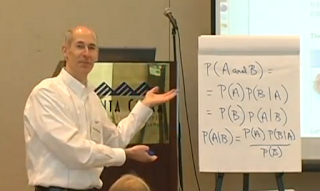And here, courtesy of PyCon and pyvideo.org, is the video. It's three hours long, so get comfortable!
Here's a screencap of me magically deriving Bayes's Theorem:
And here's the description and outline, from the PyCon page:
Description
This tutorial is an introduction to Bayesian statistics using Python. My goal is to help participants understand the concepts and solve real problems. We will use material from my book, Think Stats: Probability and Statistics for Programmers (O’Reilly Media).
Abstract
Bayesian statistical methods are becoming more common and more important, but there are not many resources to help beginners get started. People who know Python can use their programming skills to get a head start.
I will present simple programs that demonstrate the concepts of Bayesian statistics, and apply them to a range of example problems. Participants will work hands-on with example code and practice on example problems.
Students should have at least basic level Python and basic statistics. If you learned about Bayes’s Theorem and probability distributions at some time, that’s enough, even if you don’t remember it! Students should be comfortable with logarithms and plotting data on a log scale.
Students should bring a laptop with Python 2.x and matplotlib. You can work in any environment; you just need to be able to download a Python program and run it.
Outline:
- Bayes’s theorem.
- Representing probability distributions.
- Bayesian estimation.
- Biased coins and student test scores.
- Censored data.
- The locomotive / German tank problem.
- Hierarchical models and the unseen species problem.

No comments:
Post a Comment